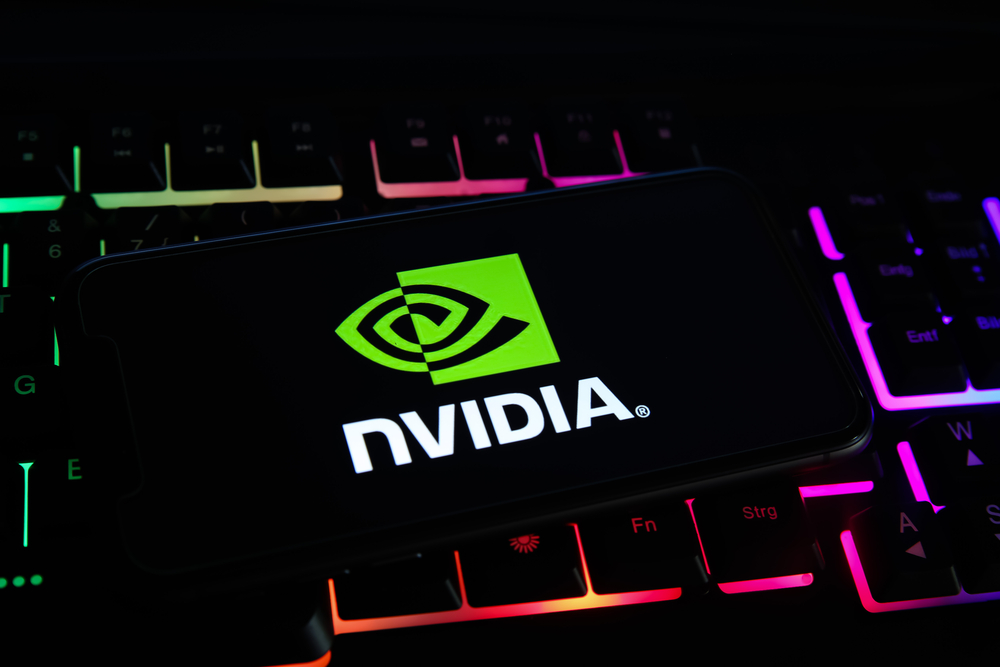

Summary
- Nvidia’s stock (NVDA) jumped by a third after its CEO forecast quarterly revenue will jump from $7bn last quarter to $11bn next quarter.
- Investors who backed NVDA a year ago clearly selected the right horse.
- The good news is that NVDA has a wide and deep moat – it is unlikely to lose its market-leading position soon.
- The bad news is that little of substance exists to support NVDA’s outlook, other than sheer excitement that science fiction’s predictions about AI could be on the verge of reality.
This article is only available to Macro Hive subscribers. Sign-up to receive world-class macro analysis with a daily curated newsletter, podcast, original content from award-winning researchers, cross market strategy, equity insights, trade ideas, crypto flow frameworks, academic paper summaries, explanation and analysis of market-moving events, community investor chat room, and more.
Summary
- Nvidia’s stock (NVDA) jumped by a third after its CEO forecast quarterly revenue will jump from $7bn last quarter to $11bn next quarter.
- Investors who backed NVDA a year ago clearly selected the right horse.
- The good news is that NVDA has a wide and deep moat – it is unlikely to lose its market-leading position soon.
- The bad news is that little of substance exists to support NVDA’s outlook, other than sheer excitement that science fiction’s predictions about AI could be on the verge of reality.
Market Implications
- Knowing what we know now, NVDA is priced for perfection. Any shortfall will likely be punished.
- NVDA is more of a trading and speculative play now. There is no way to rationally evaluate whether its outlook is realistic.
- When the AI mania subsides, we expect NVDA forecasts and valuations will too. It will likely be a buy at that point. The only question is, when will that happen?
NVDA’s Moat Is Soft(ware)
One of Warren Buffet’s criteria for evaluating companies is whether they have a ‘moat’ – a competitive advantage that is difficult for other companies to copy or encroach upon. Looking at Nvidia – the stock market darling du jour – you might wonder how secure its moat is. And does that justify its sky-high valuation? Post earnings, NVDA stock has rallied 32%, and trailing P/E has shot up from a pricy 150x to 195x…
The consensus is that NVDA’s moat is wide and deep – albeit not impenetrable. It is the market leader in producing graphical processing units (GPUs), which gamers have long sought for their speed and ability to render quality graphical images. But other semiconductor companies produce quality GPUs if a notch below NDVA.
NVDA’s competitive advantage lies less with hardware and more with software that allows people to program those GPUs for specific purposes. Much of this software is free, effectively locking customers into NVDA’s products and services.
In recent months, especially since ChatGPT came out in late 2022, a broad audience has realised NVDA’s GPUs are particularly attractive for so-called large language and generative artificial intelligence (AI) applications. Generative AI refers to models that can produce content such as narrative text, images, and audio.
NVDA’s massive stock rally has given it another advantage – namely currency to buy out small companies with emerging technology.
For the foreseeable future, investors can rest assured that NVDA has a moat that should keep it at the forefront of the semiconductor and technology sectors. But what about that valuation?
About That Valuation…
No question about it, NVDA has been nothing short of extraordinary for years (Chart 1). It was basically a market performer or laggard relative to the NASDAQ 100 (NDX) and Philadelphia Semiconductor Index (SOX).
In 2017, NVDA broke free of sector boundaries as its GPUs found use in AI applications and driverless car technology, and its earnings jumped sharply higher (Chart 2). During the first spike, NVDA’s earnings outpaced NDX by more than 500%; during the pandemic-induced gaming mania in 2021-22, NDVA earnings peaked at 830% above NDX.

Analysts are now projecting that NVDA will earn $9.20 per share over the next year, up from $2.06 over the past year. If we believe that forecast, the NDVA versus NDX gap will jump to 2,000% over the next year.
Next year’s forward earnings for NVDA start in 2019. Clearly analysts have been aggressive from the get-go. In 2019, they were projecting year-ahead earnings would rise 130% (Chart 3). It turns out they were correct – through 1Q 2022 (Chart 4). (Forecast earnings in Chart 3 were shifted forward one year in Chart 4 to match realized trailing earnings).

The big disconnect started in 2Q 2021. Analysts expected the pandemic bonanza would gather steam in 2022. They failed to reckon with rising inflation and the Fed response by early 2022 – and that the reopening would kill demand for gaming hardware.
Arguably none of this was foreseeable in early 1Q 2021. But curiously, analyst forecasts remained extraordinarily high even as NVDA earnings peaked at $4.31 in 2Q 2022 then fell by more than half to $2.05.
Maybe analysts knew something big was coming and simply ignored the factors driving the earnings and the stock down over the past year. But that hardly explains how projected earnings jumped from $5.98 to $9.12 after the earnings report. That is a monster miss.
Forward P/Es over the past few years show NVDA has tended to trade at a forward P/E multiple of 30-40 (Chart 5). Did analysts simply look at NVDA’s soaring stock price and apply an arbitrary multiple of 40 to come up with forward earnings?

What Could Go Wrong?
NVDA Misses…
NVDA’s stock rally and huge projected earnings boost depend largely on NVDA’s outlook that quarterly revenue will go from $7.2bn in the latest quarter to $11bn next quarter – up $4bn or 53%.
NVDA has an enviable track record of posting large revenue and earnings gains as it moves into new markets and introduces new products. Think twice about betting against it. Still, the prospective growth in AI-related demand is extraordinary for a mature company.
Also, no evidence yet exists that other players in the AI space expect a major upturn in revenues. Taiwan Semiconductor Manufacturing Company (TSM), for example, manufactures all the NVDA chips, but it is not forecasting an outlook in output or earnings anywhere near that implied by NVDA’s outlook.
If NVDA falls short of its lofty forecast, its stock price will be pummelled.
AI Expectations Deflate
Today, AI is riding a cushion of elevated expectations largely due to ChatGPT. Before ChatGPT, most people thought of AI becoming human-like as in the realm of science fiction. Suddenly they see AI as the dawn of a new age where machines are on the verge of replacing much of what humans do – both low-paid mundane work and highly paid professional work.
The reality is most AI will do mundane, mechanical things. ChatGPT notwithstanding, super AI that really can replicate much of what humans do may prove elusive. At some point, society and investors may decide that AI is just another computer tool and assign it a much lower earnings multiple than today.
In this scenario, NDVA could retain its market-leading position, albeit at a lower valuation.
Will AI be a Money-Maker?
Most of the money pouring into AI is hoping to find the elusive business model that mints money. But the marvels of ChatGPT have made it easy to forget how much AI is already part of our world. To cite a few examples:
- As early as 1966 MIT produced Eliza – a natural language processor computer that could converse with people. It fooled more than a few people into thinking it was a person and even a psychotherapist.
- In 1997, IBM’s Deep Blue machine beat chess world champion Gary Kasparov.
- In 2011, IBM’s Watson won at Jeopardy against three top human players.
- Today, when you enter a query in Google, you often get a quick two or three sentence answer that provides the information that you were looking for – no need to plough through a bunch of links to find the answer.
Here is the key point. None of these applications have turned into money-makers or taken over anything.
For all the whiz-bang smarts that Watson brought to the table, IBM has never been able to monetize it. IBM tried to adapt Watson for healthcare applications but ended up selling it because it could not turn a profit. Part of the problem is that IBM is notoriously bad at monetizing its R&D.
But the deeper problem is that while people might be amused that a machine can beat humans at Jeopardy, solely being good at Jeopardy-type games is neither a marketable nor usable skill.[1]
Or, alternatively, humans are good enough, and any individual brings a far broader array of necessary skills to the table. To replicate human output, you might need dozens or even hundreds of Watsons at your disposal, each one elaborately trained on massive quantities of data to do some narrow function better than humans. And then you need some super AI to coordinate all these Watsons and fill in the missing chinks.
And for all the wonders that Google has accomplished with its search engine and related AI, people do not pay for this service. Google monetizes search through selling ads. In doing so, it has disrupted the newspaper and media industries, which long relied on advertising to subsidize the cost of producing content that people wanted – but for which they would not pay the full cost.
The takeaway here is AI alone may not be much of a money-maker. It is what you do with it. Those answers are in short supply today.
The reality is that most companies flying high on AI investment and equity valuation will likely crash. It happened with PCs in the 1980s. Does anyone remember Osborne Computer? Kaypro? Grid Computer? It happened to many telecoms and innumerable ‘dot-coms’ when the internet bubble of the late 1990s burst.
AI will face a similar reckoning. Again, NVDA may be able to retain its market leadership position, but at a lower valuation.
What About that Moat?
NVDA’s advantage is largely due to its GPUs, which are the best chip for generative AI today.
If, as we think, most future AI falls short of being all-encompassing generative AI, the demand for super GPUs may be limited. Also, cloud vendors are something of an oligopoly, dominated by Amazon, Alphabet, and Microsoft. Once their demand for super GPUs is met, the remaining pipeline of orders could narrow significantly.
Further, if (as we believe) most AI will be for narrow and specialized purposes, the industry may soon gravitate toward specialized application-specific chips rather than high-cost general purpose GPUs. NVDA has the wherewithal to dominate this field. But it could be easy for smaller and more nimble chip companies to gain market share.
NVDA would remain a formidable presence in both scenarios, but its future growth and profits would be lower than current valuations imply.
Concluding Remarks
The sky-high valuations for NVDA and AI in general are clearly unsustainable. The question is, what brings them back to earth?
Amid the endless commentary about AI and ChatGPT, a few voices are questioning current valuations. But the working assumption everywhere that the future is generative AI whether for better or worse. So far, few are discussing what generative AI will actually do or how it makes money.
We think AI and NVDA will be revalued downward when investors and pundits start asking those hard questions…or if NDVA falls short on its spectacular forecasts.
[1] As far as we can tell, when long-time Jeopardy host Alex Trebek died, Watson was not asked to audition for a position as host.
Over a 30-year career as a sell side analyst, John covered the structured finance and credit markets before serving as a corporate market strategist. In recent years, he has moved into a global strategist role.
Photo Credit: depositphotos.com
